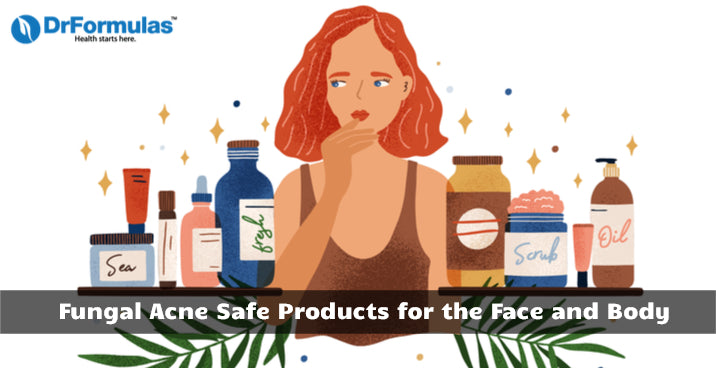Fungal Acne Skincare Routine
Part of reducing your fungal acne comes down to maintaining a regular skincare routine can help to control the oil and fungal populations on your skin while incorporating some of the above ingredients to reduce the amount of yeast on your skin. Perform this skincare routine twice per day, morning and night.
1. Cleanse
Use a gentle facial cleanser to wash away any dirt, sweat, and debris that has collected on your skin. Avoid cleansers with polysorbates, fatty acids, and most oils. Exceptions are MCT oil (capric/caprylic triglycerides), mineral oil (naturally free of fatty acids), squalane (not to be confused with squalene).
2. Toner
Toner helps to remove anything that your cleanser may have missed while also actively treating your fungal acne. Look for toners with green tea. Avoid toners with polysorbates, fatty acids, and most oils. Exceptions are MCT oil (capric/caprylic triglycerides), mineral oil (naturally free of fatty acids), squalane (not to be confused with squalene).
3. Treat and Gently Exfoliate
This is the crux of your skincare routine’s effectiveness. Apply a serum containing salicylic acid, azelaic acid, or urea to your skin, focusing on areas affected by fungal acne.
Tips on Exfoliation
About once or twice per week, apply a powerful chemical exfoliant (AHA or BHA) after using your toner. This can help to promote the shed of dead skin cells to make way for fresh skin cells. This helps to prevent clogged pores while further regulating oil production. However, exfoliating too much can be potentially irritating, which is why you should limit it to no more than twice per week.
4. Moisturize
Moisturizer is an essential step in your skincare process. It protects and nourishes your face to provide more supple, smooth skin. While moisturizer makes sense for dry skin, it’s also essential for oily skin. Avoid moisturizers with polysorbates, fatty acids, and most oils. Exceptions are MCT oil (capric/caprylic triglycerides), mineral oil (naturally free of fatty acids), squalane (not to be confused with squalene).
5. Sunscreen
Always end your morning routine by applying sunscreen. Most active ingredients will increase your skin’s sensitivity to UV rays, which can contribute to inflammation and increase your risk of skin cancer. Use a non-greasy sunscreen, even if you don’t plan to go outside. Sunlight can still come in through windows.
Recommended Fungal Acne Products
If you are not sure where to start, here are some products that we recommend for fungal acne.
- Face Cleansers
- DrFormulas Face Cleanser
- Moisturizers
- DrFormulas Hyaluronic Water Cream
- Avene Tolerance Extreme Emulsion
- Hada Labo Kin Plumping Gel Cream
- Toners
- Treatments
- Sunscreen
- Colorescience Unforgettable Mineral SPF 30
- Shampoo
- Nizoral A-D Anti Dandruff Shampoo
- Head and Shoulders Classic Clean Dandruff Shampoo (Zinc Pyrithione)
- Hegor Shampoo (1.5% Climbazole)
- DrFormulas™ HairOmega® Shampoo (1% Ketoconazole)
- Selsun Blue Medicated Dandruff (Selenium sulfide)
How to Prevent Fungal Acne
Along with fungal acne treatments, you can take a proactive step to prevent the growth of fungal acne.
- Wear breathable fabrics
Species of Malassezia thrive in warm, humid environments, making them more likely to grow when you are sweaty and hot. Wear breathable fabrics to reduce sweat and body heat, and remember to rinse and bathe immediately after workouts to reduce the chance of overgrown yeasts.
- Avoid most face oils
As mentioned, Malassezia feed primarily on oils and fatty acids, so it’s a good idea to avoid most face oils and fatty acids. Avoid most products using esters, which comprise a fatty acid combined with a glycerol or alcohol, aside from capric and caprylic acid.7 Other oils to avoid include:
- Polysorbates
- Galactomyces
- Squalene (a component of human sebum)
- Phytosphingosine
Face oils that are safe to use include:
- MCT oil (capric/caprylic triglycerides)
- Mineral oil (naturally free of fatty acids)
- Squalane (not to be confused with squalene)
- Exfoliate
Exfoliating breaks down dead skin cells and debris to prevent clogged pores, while also regulating skin oils and dirt that may promote the growth of yeast cells. Use a gentle chemical exfoliator, and avoid harsh scrubs as they may irritate the skin and create microtears.
- See a dermatologist
The worst thing you can do is treat your fungal acne like traditional acne. Aside from not helping your condition, certain traditional acne treatments may exacerbate the symptoms of fungal acne. Unfortunately, it’s far too easy to mistake the two. The best way to know for sure is to see your dermatologist.
Fungal acne presents symptoms that are distinct from conventional acne, but with the right treatments and preventive measures, you can reduce your fungal acne and maintain clear, healthy skin.



